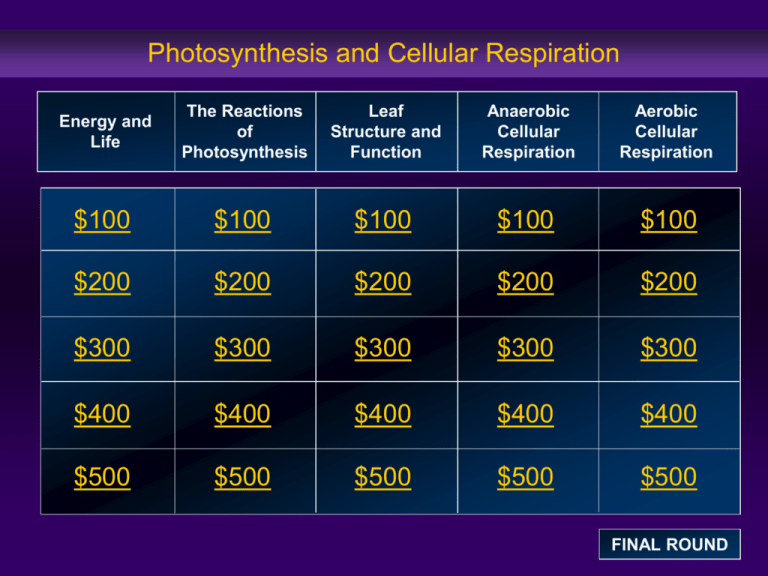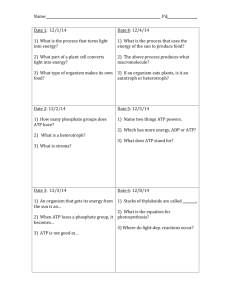Photosynthesis and Cellular Respiration Jeopardy Review
advertisement

Photosynthesis and Cellular Respiration Energy and Life The Reactions of Photosynthesis Leaf Structure and Function Anaerobic Cellular Respiration Aerobic Cellular Respiration $100 $100 $100 $100 $100 $200 $200 $200 $200 $200 $300 $300 $300 $300 $300 $400 $400 $400 $400 $400 $500 $500 $500 $500 $500 FINAL ROUND Topic 1: $100 Question Where does the energy of food originally come from? ANSWER BACK TO GAME Topic 1: $100 Answer Light energy that is captured by autotrophs using photosynthesis. BACK TO GAME Topic 1: $200 Question What is the principal chemical compound that organisms use to deliver energy where it is needed to perform life processes? ANSWER BACK TO GAME Topic 1: $200 Answer ATP BACK TO GAME Topic 1: $300 Question What are two ways in which cells use the energy provided by ATP? ANSWER BACK TO GAME Topic 1: $300 Answer Possible answers include: Active Transport Cell Movement BACK TO GAME Topic 1: $400 Question Why is it efficient for cells to keep only a small supply of ATP on hand? ANSWER BACK TO GAME Topic 1: $400 Answer ATP can only store energy for short periods of time. As a result, it must constantly be generated within cells. BACK TO GAME Topic 1: $500 Question What is the source of energy to regenerate ATP? What two molecules are joined to form ATP using this energy? ANSWER BACK TO GAME Topic 1: $500 Answer The energy to join ADP with phosphate to form ATP comes from carbohydrates like glucose. BACK TO GAME Topic 2: $100 Question Write the overall equation for photosynthesis using both words and a balanced chemical equation. ANSWER BACK TO GAME Topic 2: $100 Answer Carbon dioxide + Water Glucose + Oxygen 6CO2 + 6H2O C6H12O6 + 6O2 BACK TO GAME Topic 2: $200 Question What does photosynthesis require in addition to water and carbon dioxide? ANSWER BACK TO GAME Topic 2: $200 Answer Light energy and chloroplasts BACK TO GAME Topic 2: $300 Question In what regions of the visible spectrum does chlorophyll absorb light very well? ANSWER BACK TO GAME Topic 2: $300 Answer Red and Blue BACK TO GAME Topic 2: $400 Question Where do the light-dependent reactions take place? AND Which of the following is/are true about the light-dependent reactions. a. They convert ADP into ATP. b. They produce oxygen gas. c. They convert oxygen into carbon dioxide. d. They convert NADP+into NADPH. ANSWER BACK TO GAME Topic 2: $400 Answer The light-dependent reactions take place in the thylakoid membranes of the grana The following are true about the lightdependent reactions. a. They convert ADP into ATP. b. They produce oxygen gas. c. They convert oxygen into carbon dioxide. d. They convert NADP+ into NADPH. BACK TO GAME Topic 2: $500 Question Where do the light-independent reactions take place? Which of the following is/are true about the light- independent reactions. a. The main products of the light-independent reactions are six carbon dioxide molecules. b. Carbon dioxide molecules enter the light-independent reactions from the atmosphere. c. Energy from ATP and high-energy electrons from NADPH are used to convert carbon dioxide molecules into glucose molecules. d. The light-independent reactions use six molecules of carbon dioxide to produce a single 6-carbon sugar ANSWER molecule. BACK TO GAME Topic 2: $500 Answer The light-independent reactions take place in the stroma The following are true about the light- independent reactions. a. The main products of the light-independent reactions are six carbon dioxide molecules. b. Carbon dioxide molecules enter the light-independent reactions from the atmosphere. c. Energy from ATP and high-energy electrons from NADPH are used to convert carbon dioxide molecules into glucose molecules. d. The light-independent reactions use six molecules of carbon dioxide to produce a single 6-carbon sugar molecule. BACK TO GAME Topic 3: $100 Question What is the name and function of structure A? A ANSWER BACK TO GAME Topic 3: $100 Answer The palisade layer is the main location where photosynthesis occurs BACK TO GAME Topic 3: $200 Question What is the name and function of structure B? B ANSWER BACK TO GAME Topic 3: $200 Answer The waxy cuticle helps prevent water loss from the leaf BACK TO GAME Topic 3: $300 Question What is the name and function of structure C? C ANSWER BACK TO GAME Topic 3: $300 Answer The vein, composed of xylem and phloem, conducts materials to and from leaf tissues BACK TO GAME Topic 3: $400 Question What is the name and function of structures D and E? D E ANSWER BACK TO GAME Topic 3: $400 Answer D- The stomate allows gas exchange between the leaf and the environment E- The guard cells form and regulate the size of the stomate BACK TO GAME Topic 3: $500 Question What is the name and function of structure F? F ANSWER BACK TO GAME Topic 3: $500 Answer The spongy layer provides air spaces so that atmospheric gases can reach deep into the interior of the leaf BACK TO GAME Topic 4: $100 Question What are the main differences between anaerobic and aerobic cellular respiration? ANSWER BACK TO GAME Topic 4: $100 Answer Anaerobic: no O2 needed, little energy released from glucose Aerobic: O2 needed, lots of energy released from glucose BACK TO GAME Topic 4: $200 Question What are the two main stages of anaerobic cellular respiration and where do they occur within a cell? ANSWER BACK TO GAME Topic 4: $200 Answer Glycolysis Fermentation Both occur in the cytoplasm BACK TO GAME Topic 4: $300 Question What are the three major products of glycolysis? How many molecules of each product are made per glucose? ANSWER BACK TO GAME Topic 4: $300 Answer Glycolysis produces: a net of 2ATP’s (use 2, produce 4) 2 NADH’s 2 pyruvic acids BACK TO GAME Topic 4: $400 Question How does fermentation allow glycolysis to continue? ANSWER BACK TO GAME Topic 4: $400 Answer Fermentation recycles the carrier molecule NADH back to NAD+. BACK TO GAME Topic 4: $500 Question What are the two main types of fermentation? What are the products of each type? During rapid exercise, how do your muscle cells produce ATP? ANSWER BACK TO GAME Topic 4: $500 Answer The two main types of fermentation are: 1. Alcoholic: produces ethyl alcohol and carbon dioxide 2. Lactic Acid: produces lactic acid When O2 levels are low, human muscle cells rely on lactic acid fermentation to produce ATP BACK TO GAME Topic 5: $100 Question What are the main stages of aerobic cellular respiration and where do they occur within a cell? ANSWER BACK TO GAME Topic 5: $100 Answer Glycolysis Kreb’s Cycle ETC* *electron transport chain Glycolysis occurs in the cytoplasm Kreb’s and ETC occur in the mitochondria BACK TO GAME Topic 5: $200 Question How many molecules of ATP are produced in the complete breakdown of glucose during aerobic cellular respiration? ANSWER BACK TO GAME Topic 5: $200 Answer 36 ATP’s BACK TO GAME Topic 5: $300 Question During the energy extraction part of the Krebs cycle, how many molecules of CO2 are released per glucose? ANSWER BACK TO GAME Topic 5: $300 Answer 6 molecules of CO2 (3 for each of the two pyruvic acids that enter the cycle) BACK TO GAME Topic 5: $400 Question From where does the electron transport chain get the highenergy electrons that are passed down the chain? ANSWER BACK TO GAME Topic 5: $400 Answer The electrons are carried to the electron transport chain by NADH and FADH2 molecules. (The original source of these electrons is hydrogen atoms from glucose.) BACK TO GAME Topic 5: $500 Question What is the energy of the high-energy electrons used for every time 2 high-energy electrons move down the electron transport chain? ANSWER BACK TO GAME Topic 5: $500 Answer The energy is used to actively transport H+ particles across the inner mitochondrial membrane. The concentration gradient that is created is then used to power the production of ATP. BACK TO GAME Comparing Photosynthesis and Cellular Respiration FINAL ROUND Question If photosynthesis is the process that “deposits” energy in a “savings account,” then what is cellular respiration? ANSWER BACK TO GAME FINAL ROUND Answer Cellular respiration “withdraws” the energy that was deposited by photosynthesis and re-invests the energy into ATP. BACK TO GAME







